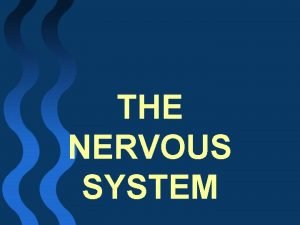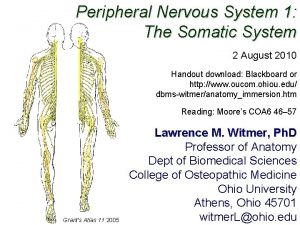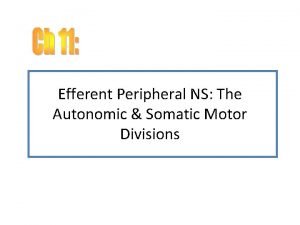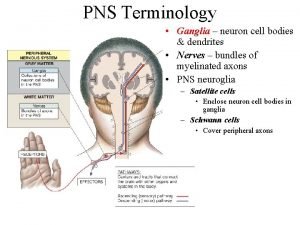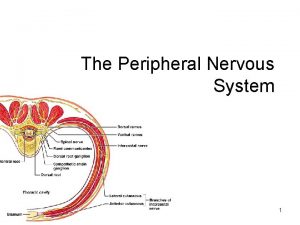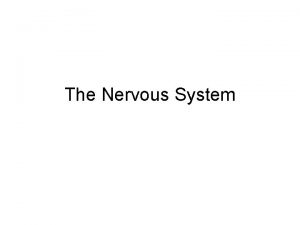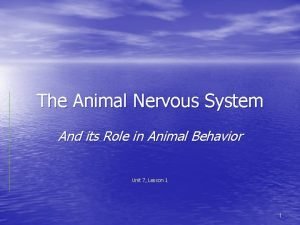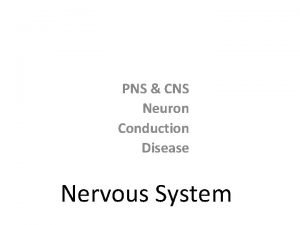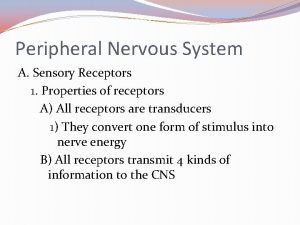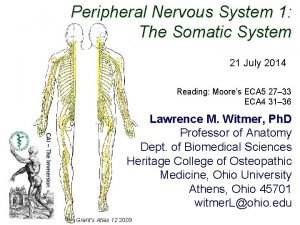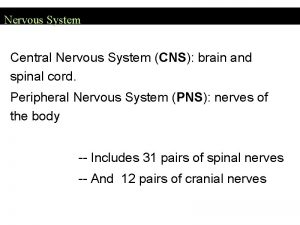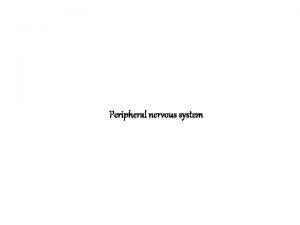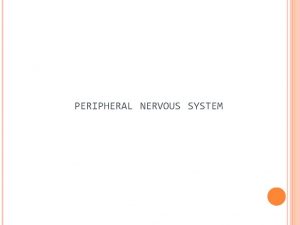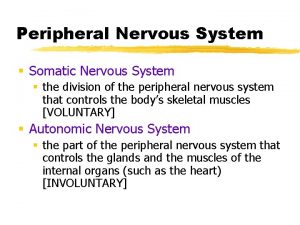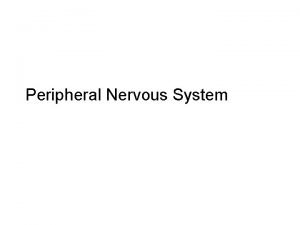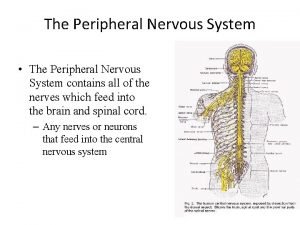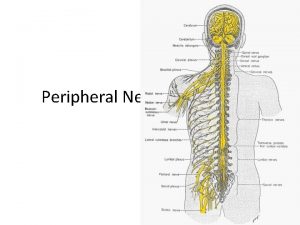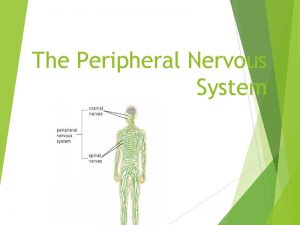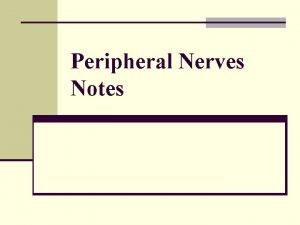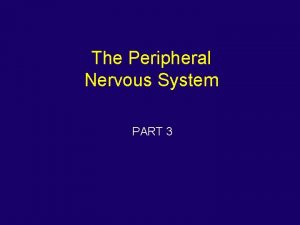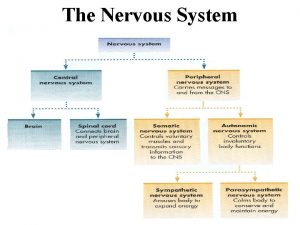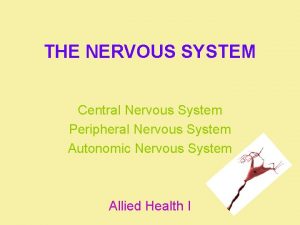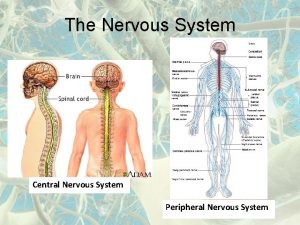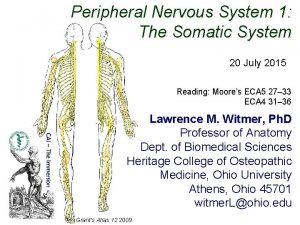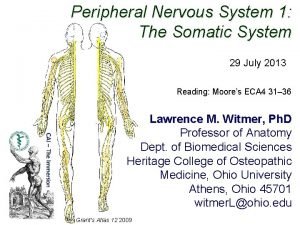Peripheral Nervous System Somatic Nervous System the division




![The Brainstem § Medulla [muh-DUL-uh] § base of the brainstem § controls heartbeat and The Brainstem § Medulla [muh-DUL-uh] § base of the brainstem § controls heartbeat and](https://slidetodoc.com/presentation_image/69f7f60e076ce701a92936f65c1f68d8/image-5.jpg)

![The Brainstem § Cerebellum [sehr-uh. BELL-um] § the “little brain” attached to the rear The Brainstem § Cerebellum [sehr-uh. BELL-um] § the “little brain” attached to the rear](https://slidetodoc.com/presentation_image/69f7f60e076ce701a92936f65c1f68d8/image-7.jpg)


![The Limbic System § Amygdala [ah-MIG-dah-la] § two almond-shaped neural clusters that are components The Limbic System § Amygdala [ah-MIG-dah-la] § two almond-shaped neural clusters that are components](https://slidetodoc.com/presentation_image/69f7f60e076ce701a92936f65c1f68d8/image-10.jpg)
















- Slides: 26

Peripheral Nervous System § Somatic Nervous System § the division of the peripheral nervous system that controls the body’s skeletal muscles [VOLUNTARY] § Autonomic Nervous System § the part of the peripheral nervous system that controls the glands and the muscles of the internal organs (such as the heart) [INVOLUNTARY]

Autonomic Nervous System § Sympathetic Nervous System § division of the autonomic nervous system that AROUSES the body, mobilizing its energy in stressful situations § Parasympathetic Nervous System § division of the autonomic nervous system that CALMS the body, conserving its energy

Sympathetic and Parasympathetic

The Brainstem • the oldest part and central core of the brain, beginning where the spinal cord swells as it enters the skull • responsible for automatic survival functions
![The Brainstem Medulla muhDULuh base of the brainstem controls heartbeat and The Brainstem § Medulla [muh-DUL-uh] § base of the brainstem § controls heartbeat and](https://slidetodoc.com/presentation_image/69f7f60e076ce701a92936f65c1f68d8/image-5.jpg)
The Brainstem § Medulla [muh-DUL-uh] § base of the brainstem § controls heartbeat and breathing § Pons § Connects different brain regions together § Involved in facial expressions

The Brainstem § Reticular Formation § a nerve network in the brainstem that plays an important role in controlling arousal § Thalamus [THAL-uh-muss] § the brain’s sensory switchboard, located on top of the brainstem § it directs messages to the sensory receiving areas in the cortex and transmits replies to the cerebellum and medulla
![The Brainstem Cerebellum sehruh BELLum the little brain attached to the rear The Brainstem § Cerebellum [sehr-uh. BELL-um] § the “little brain” attached to the rear](https://slidetodoc.com/presentation_image/69f7f60e076ce701a92936f65c1f68d8/image-7.jpg)
The Brainstem § Cerebellum [sehr-uh. BELL-um] § the “little brain” attached to the rear of the brainstem § it helps coordinate voluntary movement and balance § Formulates implicit memories

The Limbic System • a doughnut-shaped system of neural structures at the border of the brainstem and cerebral hemispheres • associated with emotions such as fear and aggression and drives such as those for food and sex • includes the hippocampus, amygdala, and hypothalamus.

The Limbic System
![The Limbic System Amygdala ahMIGdahla two almondshaped neural clusters that are components The Limbic System § Amygdala [ah-MIG-dah-la] § two almond-shaped neural clusters that are components](https://slidetodoc.com/presentation_image/69f7f60e076ce701a92936f65c1f68d8/image-10.jpg)
The Limbic System § Amygdala [ah-MIG-dah-la] § two almond-shaped neural clusters that are components of the limbic system and are linked to emotion (specifically aggression and fear)

The Limbic System § Hypothalamus § neural structure lying below (hypo) the thalamus; directs several maintenance activities § Eating and drinking § Sex drive § body temperature § helps govern the endocrine system via the pituitary gland

Hypothalamus Stimulation § Electrode implanted in reward center of hypothalamus § Rat readily crosses to get stimulation

The Limbic System z. Hippocampus: a structure in the limbic system linked to explicit memory (Clive Wearing example) z. Pituitary Gland: master endocrine gland, linked to growth (Andre the Giant example) zhttps: //www. youtube. com/watch? v=Jf. Pa. L -YWZPM

The Cerebral Cortex z The main part of the brain is the cerebrum – big piece of folded, wrinkly meat that covers the older more primitive limbic system & brainstem. z Gyri are the grooves in the brain & Sulci are the humps in between the grooves. z Newer neural networks within the cerebrum form specialized work teams that enable our perception, thinking and speaking. z Covering our cerebral hemispheres is the thin cap or cerebral cortex. This is your body’s ultimate control & info-processing center.

The Structure of the Cortex z 20 -23 billion nerve cells with 300 trillion synaptic connections. z. Neuroglia –Glial Cells: category of neural cells that provide support network of cells surrounding the neurons & blood vessels of the brain & nervous system. z. Each hemisphere is divided into four lobes: frontal lobe, parietal lobe, occipital lobe & temporal lobe.

The Cerebral Cortex Laid out it would be about the size of a large pizza. Cerebral Cortex the intricate fabric of interconnected neural cells that covers the cerebral hemispheres

The Cerebral Cortex § Frontal Lobes § involved in speaking and muscle movements and in making plans and judgments (Phineas Gage Clip) § Parietal Lobes § Involved in sensations (touch), pressure, and pain

The Cerebral Cortex § Occipital Lobes § include the visual areas, which receive visual information from the opposite visual field § Temporal Lobes § include the auditory areas

The Cerebral Cortex § Motor Cortex § area at the rear of the frontal lobes that controls voluntary movements § Sensory Cortex § area at the front of the parietal lobes that registers and processes body sensations

The Cerebral Cortex

The Cerebral Cortex § Functional MRI scan shows the visual cortex activated as the subject looks at faces

Association Area z¾ of the cerebral cortex is uncommitted to sensory or muscular activity z. Neurons in these association areas integrate information & therefore cannot be neatly mapped z. Found in all four lobes & increase in more intelligent animals.

Association Areas § “Uncommitted” areas that are not involved in primary functions but play a role in learning, remembering, and thinking § More intelligent animals have increased “uncommitted” or association areas of the cortex

Association Area zi. e. : In frontal lobes assoc areas enable judgment, planning & processing of new memories. Damage to frontal lobe can also alter personality = Phineas Gage z. In parietal lobes assoc areas, they enable math & spatial reasoning… z. In temporal lobes facial recognition z{*these are just a few examples!!!!}

Broca’s Area z. Controls speech muscles via the motor cortex z. Damage to Broca’s area (Broca’s aphasia): prevents a person from producing speech • person can understand language • words are not properly formed • speech is slow and slurred

Wernicke’s Area z. Interprets auditory code z. Damage to the Wernicke’s Area (Wernicke’s Aphasia): zloss of the ability to understand language zperson can speak clearly, but the words that are put together make no sense. This way of speaking has been called "word salad" because it appears that the words are all mixed up like the vegetables in a salad.
 Somatic nervous system (sns)
Somatic nervous system (sns) Somatic nervous system
Somatic nervous system Ciliary ganglion
Ciliary ganglion Visceral nervous system
Visceral nervous system Somatic nervous system
Somatic nervous system Autonomic nervous system pathway
Autonomic nervous system pathway Dermatome map
Dermatome map Nervous system major divisions
Nervous system major divisions Autonomic nervous system pathway
Autonomic nervous system pathway Somatic nervous system
Somatic nervous system Medunerve
Medunerve Major division
Major division Peripheral nervous system
Peripheral nervous system Nervous system divisions
Nervous system divisions Hydra neurons
Hydra neurons Peripheral nervous system consists of
Peripheral nervous system consists of Youtub.eoc
Youtub.eoc Involuntary movements
Involuntary movements Peripheral nervous system
Peripheral nervous system Peripheral nervous system
Peripheral nervous system Peripheral nervous system
Peripheral nervous system Peripheral nervous system medications
Peripheral nervous system medications Identify each type of neuronal pool
Identify each type of neuronal pool Fundamentals of the nervous system and nervous tissue
Fundamentals of the nervous system and nervous tissue Processes neuron
Processes neuron Peripheral nervous sysytem
Peripheral nervous sysytem Label the parts of the main divisions of the nervous system
Label the parts of the main divisions of the nervous system

